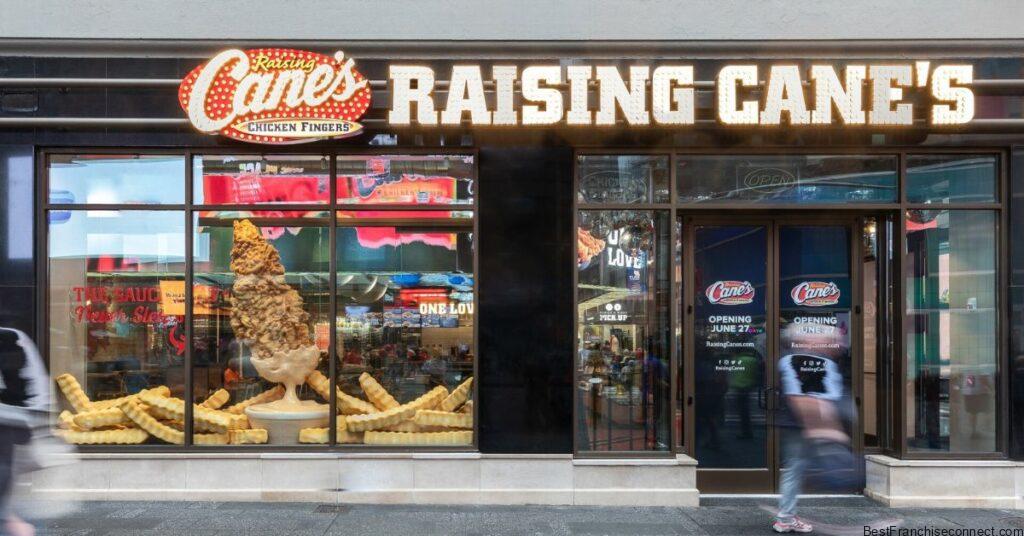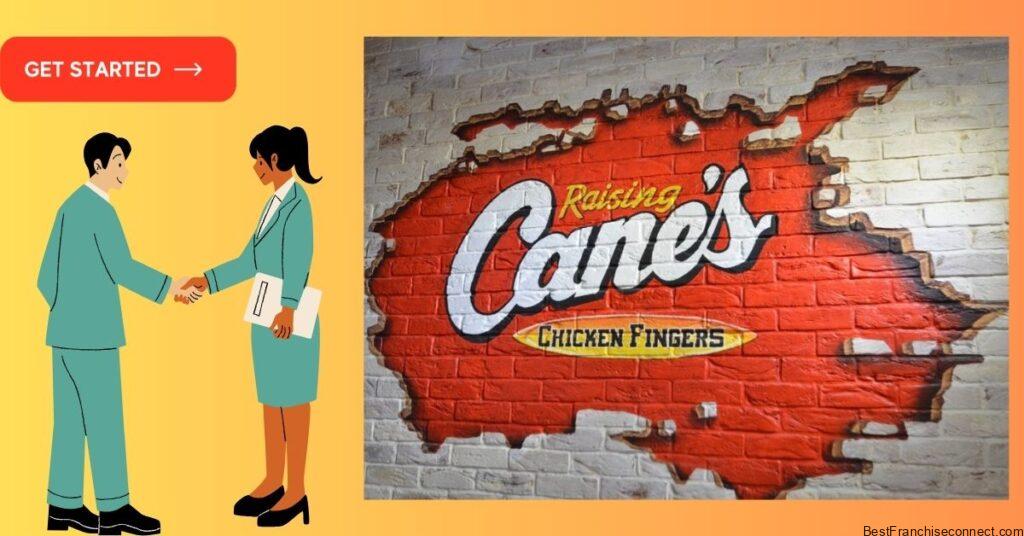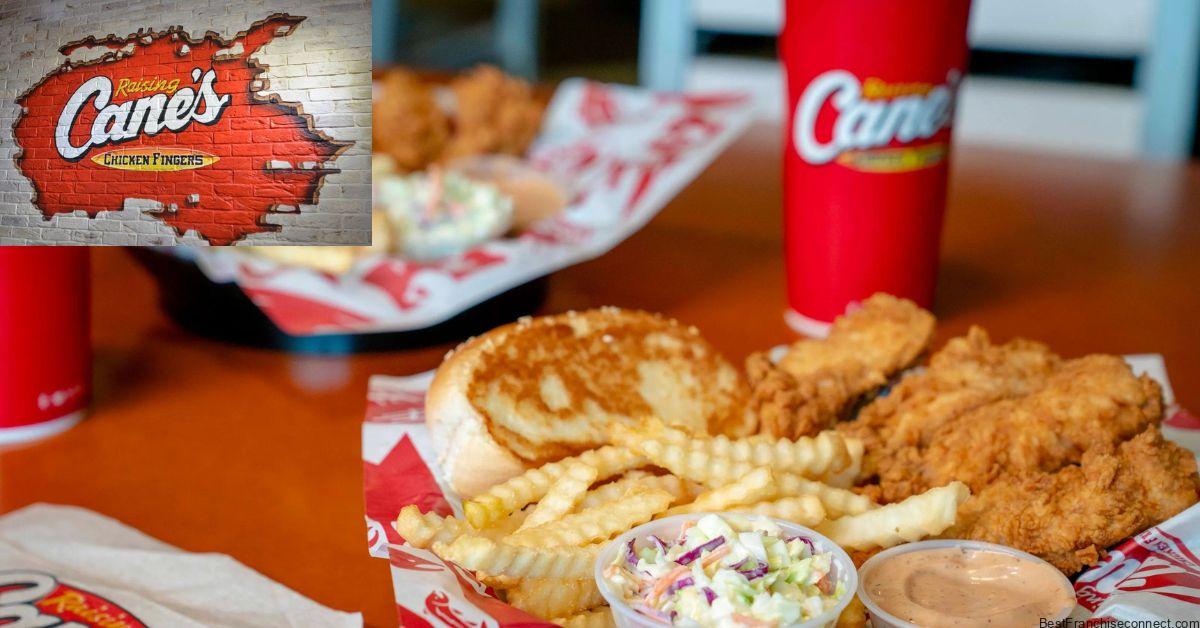Raising Cane’s Chicken Fingers is a fast-growing fast-food restaurant chain that has a unique selling proposition in offering chicken fingers. Created by Todd Graves in 1996 in Baton Rouge, Louisiana, Raising Cane’s has grown to operate more than 432 restaurants across 27 states in the USA and in another 21 restaurants in the Middle East countries such as Kuwait, Saudi Arabia, Bahrain, Lebanon, and the United Arab Emirates among others.
This article will offer a detailed insight into Raising Cane’s franchise, including the initial capital, recurrent costs, franchise options, and profitability. Some important factors are involved when starting a Raising Cane’s Chicken Fingers franchise and this guide shall make everything a bit easier for you to understand.
Table of Contents
History and Contribution of Raising Cane’s
1996: Raising Cane’s Chicken Fingers company was started by Todd Graves and Craig Silvey at the University of Louisiana State. It was realized that a simple, high-quality menu is easy to sell and it can be rather profitable to focus on one kind of dish.
2000: A result of its ability to continually provide quality meals and outstanding consumer relations the company’s outlet, Raising Cane, began opening its outlets across different states within the United States of America and became a beloved fast food joint for chicken consumers.
2015: Evidently, the company, Raising Cane’s, opened its first restaurant situated outside the United States in Kuwait. Since then the brand has expanded and now operates in several locations within the Middle Eastern region.
Present Day: With now over 600 stores in the world, the company has managed to sustain fresh, hand-battered chicken fingers served hot and fast.
Raising Cane’s Chicken Menu: A Small but Global Solution
Another objective characteristic of the restaurant chain is its narrow specialization in a limited number of products. The restaurant only offers chicken fingers, fries, coleslaw, Texas toast, and Cane’s Sauce as their specialty. By following this simple procedure, there is direct access, therefore efficiency, and conformity, which are crucial in the fast-food market segment.
One of the major factors of its success can be attributed to the quality of the food it serves. These include offering only fresh, never-frozen chicken that is hand battered on the spot, and using freshly prepared sides. And this commitment has indeed given the brand a loyal customer base.
Characteristics of Raising Cane’s Franchise
Simple Menu: This is good for reducing waste since more customers will be attended to, the meals will be prepared in large portions, and takes little time to serve them and this will make the restaurants profitable.
Fresh Ingredients: Fresh chicken and other ingredients, never frozen, are ever used in Raising Cane’s restaurants so that each time a customer visits, he is served the best product.
Efficient Operations: The reduced number of offered items makes it easier to control the staff, train them, and equalize the results in different outlets.
Rapid Growth: Currently, Raising Cane’s has over 600 stores, in both the United States and other countries, meaning that the franchise business is still growing, which is good for franchisees.
Raising Cane’s Franchise step-by-step guide

If you’re interested in owning a Raising Cane’s franchise, here’s a step-by-step guide on how to proceed:
Control and maintain sufficient capitalization
Net-Worth Requirement: For Raising Cane’s, one requires a minimum net worth of $768,000 to own a franchise restaurant. This guarantees the financial capacity to support the start-up capital cost and continue the financial operations.
Understand the Investment
Total Initial Investment: The initial investment recommended for a start-up Raising Cane’s franchised restaurant is between $768,100 to $1,937,500. These are; Real estate, equipment, Signage and any other clothing or accessories, Insurance costs, permits, etc.
Evaluate Your Experience
Check your business experience before submitting your application. Formal experience in the restaurant business is not mandatory, however, a good business head and managerial skills are desirable for a franchise biz.
Assess Market Availability
But, go through the available markets in the area you wish to venture to before you apply for one. It will be discovered how the provision of territories can either make or mar your franchise.
Submit Your Application
You should therefore ensure that the market is available, that your financial arrangements are correct, and submit your application. The franchise team of Raising Cane’s will go through it and get in touch with you regarding further proceedings.
Obtain permission and commence operations
When you clear all the financial and background clearance then you will be granted approval to start your franchise. You shall then be trained and mentored on how to run the restaurant for Raising Cane’s franchised restaurants.
Investment Criteria of Franchise
Romance your taste buds with food from Raising Cane’s, but first, be ready to part with a lot of cash to set up a franchise.
| Franchise Fee | $45,000 |
| Initial Inventory | $12,000 to $25,000 |
| Training expenses | $20,000 to $45,000 |
| Royalty Fees | 5% |
| Marketing Fees | 4% |
| Working Capital or Other Expenses | $50,000 to $150,000 |
| Net-Worth Requirement | $90,000 to $250,000 |
| Total Raising Cane’s Franchise | $800,000 to $2,000,000 |
These include accommodation expenses, equipment expenses, marketing expenses, employee’s uniform expenses, etc. The total investment is dependent on the establishment size and location of the restaurant business.
Cost Analysis of Raising Cane’s Franchise

The initial investment of Raising Cane’s Franchise is $800,000 to $2,000,000 can be broken down into the following categories:
Franchise Fee: The cost of entry for starting a Raising Cane is $45,000. This entitles you to the usage of the company’s name, logo, as well as business model.
Setup Costs: The fixed interior expenses mean expenditures on the development of your restaurant and the interiors of the kitchen, the dining areas, signs, and fixtures and equipment in the kitchen actually account for a sizeable portion of the overall expense.
Licenses and Permits: Predominantly licenses and permits required in running a franchise business may include health permits, business licenses, and food handling permits.
Marketing Expenses: Cane’s has rules that each franchisee has to engage in local and company advertising to spread awareness of the brand and customers.
Working Capital: To provide for the daily, weekly, and monthly expenses in the early period of a business, you will require working capital.
Profitability of Raising Cane’s, the Fast Growing Fast Food Franchise
Although there is no guaranteed formula to success, a number of factors make Raising Cane’s franchise thrive financially. Here are a few key components:
Average Unit Volume (AUV): $4.6 million
Therefore, Auv, which stands for average revenue as far as the Raising Cane’s restaurant is concerned with the annual, is one of the measures of profitability. As much as we can approximate the numbers depending on the region and particular demand on the market, the restaurants located in central areas are particularly lucrative.
Profit Margins
Raising Cane’s describes its profit margins for a franchise at a target set for between 15% and 25%. These non-fixed overheads depend on a number of variables like operating capacity, cost of food prepared, and cost of employees.
Return on Investment (ROI)
And the franchisee is likely to refund the initial investment in 4 to 6 years at most. The company’s efficient locations may gain higher revenue or profit quicker compared to others especially when they operate in a market with a large customer base and minimal cost.
Franchise in International Markets
Raising Cane’s has expanded beyond the United States into several international markets, including:
Kuwait: Originally, Raising Cane’s opened its first cross-border restaurant in Kuwait in the year 2015. The chain today operates six of what is no longer known as fast food restaurants in the country.
Saudi Arabia: The quantitative research shows that at the time of writing this paper, there are only 11 Raising Cane restaurants in Saudi Arabia.
Bahrain: Two have been launched in Bahrain.
Lebanon: Till now only one location has been set up in Lebanon.
United Arab Emirates: As of now, Raising Cane’s only branch in the UAE reported little to no problems.
Regional criteria for becoming a Raising Cane’s franchisee
To qualify for a Raising Cane’s franchise, you must meet the following eligibility criteria:
Net Worth: $90,000 to $250,000
Initial Investment: $800,000 to $2,000,000
Franchise Fee: $45,000
Prior Business Experience: Restaurant experience isn’t necessarily required, but having experience in business or management is preferred.
How to Start Raising Cane’s Chicken Fingers as a Franchise

- To apply for a Raising Cane’s franchise, follow these steps:
- Go to the company website Raising Cane’s Chicken and visit the franchise tab.
- The online franchise application form has to be filled in.
- Once you have entered all the details, you get a receipt and information about a franchise representative.
- After you submit your application, it will be evaluated; financial and background checks will be conducted on you.
After approval, they get ample training on how to carry out their restaurant business.
Pros and Cons of Raising Cane’s Franchise
| Pros | Cons |
| Strong brand recognition | High initial investment |
| Simple, efficient operations | Competitive fast-food market |
| The usual high demand for chicken fingers as the core product. | Limited menu offering |
| Full franchising services | |
| Market growth opportunities at the international level |
Also Read: Hoodz Franchise Cost, Profit and How to Get in 2025?
Juiceland Franchise Cost, Profit and How to Apply in 2025?
How Profitable Is a 7 Brew Franchise in 2024?, Cost & Apply
La Michoacana Franchise Cost, Profit and How to Start in 2025?
Conclusion
In Conclusion, Raising Cane’s Franchise Cost, Profit, and How to Get? 2025. Franchising with Raising Cane’s is a good investment for individuals interested in owning a fast-food joint business. Given a good and long-standing brand image, loyal clientele base, and sustainable business strategy, franchisees have the potential to achieve high levels of profitability with good return on investments. Due to its focus on quality, eliminating the superfluous and lean operation structure, the company would appeal to people who seek to leave a mark in the restaurant business.
FAQ
How much will it cost me to open a Raising Cane’s restaurant?
The total initial investment varies from $800,000 to $2,000,000 contingent upon the site and size of the restaurant.
What are Raising Cane’s franchising costs?
The franchise fee at the period of the organization is equal to $45000.
When does one become profitable?
As for the expectations of ROI, they amount to 4 to 6 years in most cases of franchised businesses

I am the admin and content writer for Bestfranchiseconnect. With over three years of experience, I provide valuable insights and engaging content on franchising. My commitment to delivering high-quality information ensures that Bestfranchiseconnect remains a trusted resource for franchise enthusiasts. Connect with me for expert advice and comprehensive guides.
